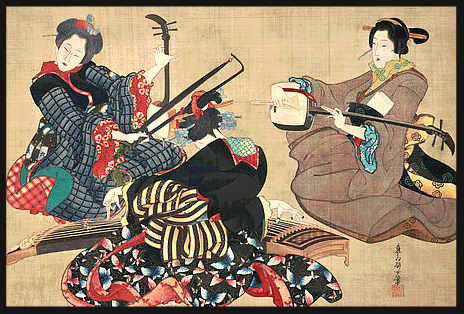Japanese traditional music is structurally different from European classical music in that heterophony (multiple voices loosely following a single melody line) is much more prevalent than homophony (a melodic line supported by a rhythmic chord progression). Oftentimes in songs, the vocal and shamisen parts may seem to lag behind one another or "dance around" each other. Sometimes the rhythmic offset of instrument and vocal lines can result in a layered "canon-like" texture. This variance in melodic line is generally greater in Japanese music than in other heterophonic music genres (Chinese music, for example)
.
Additionally, each instrument has their own set of stylistic ornaments/articulations which are used to create a sense of orchestral depth (such as in Gagaku or Sankokyu). Other times, instruments and vocals may engage in a kind of call and response dialogue (for example in biwa music). Koto music, however, tends to have a greater sense of harmony, due to the sustained nature of their string sound. Because the koto is tuned to open chords, this adds to the harmonic effect.
Historically, music in Japan has grown around ritual ceremonies (Gagaku, Kagura), story recitals (Heike-biwa), practical work settings (Dengaku, folk songs) and theatrical productions (Noh, Kabuki). In the more recent Edo period, the "pleasure districts" (as portrayed in the ukiyo-e ("floating world") woodcuts of the period) created a market for more private song recital genres such as those accompanied by shamisen and geisha. In the meantime, playing the koto at home was an activity which indicated a civilized upbringing (much like how learning how to play the piano is in the modern world). Other instruments were historically popularized by their use as portable accompaniment for wandering priests or ronin spies (shakuhachi, biwa).
Below is a brief rundown of the major periods in Japanese history and the musical developments associated with them (extrapolated from the pull-out chart in William Malm's excellent book on Japanese music). At right are links which may be followed in order (they are listed roughly chronologically) or by genre/instrument.
| Period | Era |
Styles Introduced
|
|
| Pre- historic |
Yayoi/Kofun/ Asuka (Yamato) 2nd C BC– 7th C AD |
Folk music is produced by indigenous people (prior to contact with China). Instruments includes the wagon zither (Yamato-goto), flute
(Yamato-bue), and percussion (all mostly represented only by sculptures).
|
|
| Ancient | Nara 710-794 |
Religious and secular
music migrates from China, Korea, and India and melds with indigenous styles, producing early forms of religious and folk music.
|
|
| Heian 794-1185 |
This is the era of the Genji/Heike War. Imported styles develop into true Japanese forms such as Gagaku court music (sometimes with chorus/dance). Poetry is accompanied by biwa and Shômyô Buddhist hymns are chanted.
|
||
| Medieval | Kamakura 1185-1333 |
The Japanese-language Wasan Buddhist chant develops. The prior era's Genji-Heike war is related in Heikyoku (Heike Monogatari epics with
biwa). Vocal and dramatic music is popularized.
|
|
| Muromachi/ Momoyama 1336-1603 |
Various genres and venues proliferate, notably Noh (Nô) drama, kouta
(short ditties with closed fan as percussion), and street corner recitations. Instruments such as shakuhachi are played by wandering religious soloists, and jamisen (shamisen) and koto are introduced.
|
||
| Modern | Edo (Tokugawa) 1603-1868 |
This era represents the high point of Japanese hōgaku. Urban music flourishes in "pleasure
districts" of Tokyo, Osaka and Kyoto in the form of Kabuki and Bunraku (puppet) theater, as well as in vocal soloists accompanied with instruments (koto, shakuhachi, biwa,
and shamisen). New forms are popularized: Gidaiyu, Kiyomoto, Tokiwazu, Nagauta, Kouta, Jiuta,
Joruri. Odori festival folk dance develops.
|
|
| Contemp- orary |
Meiji 1868-1912 |
The re-opening of the country to the West produces a fusion of Western (nationalistic) styles and instruments with traditional ones, as native genres continue to develop new sub-genres.
|
|
| Post-Meiji | Taisho/Showa |
Avant-garde techniques inspired by Western practices encourage expansion of technique and new styles.
|
|
The primary sources for the information presented here is William P. Malm's "Japanese Music and Musical Instruments" (Tuttle, 1959), Wikipedia, and Britannica, as well as various CD booklet notes in my collection (most notably the King Records' 2003 10 CD set).


No comments:
Post a Comment